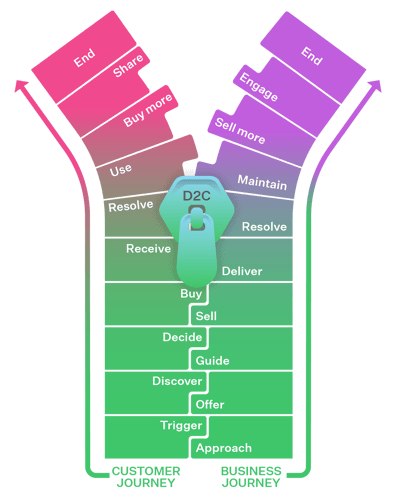Do any of these slogans sound familiar to you? "Unlock the Power of Customer Data!", "Improve Customer Focus!" "Own the Total Experience!", "Maximize Customer Lifetime Value". They are used to urge businesses to court and groom their customers.
For manufacturing companies that sell their products through wholesales and retailers, or other B2B partner networks, this is not as trivial as it sounds. They first need even the basic means for getting closer to their customers - starting from having at all a clue about who is the buyer of their product and how to contact them.
This is exactly where the Direct-to-Consumer (D2C) business model comes into the game. D2C is built on the premise of mutual interest between brands and their customers: Brands want to get closer to their customers, and customers want to deal more directly with their preferred brands.
 Figure: Zipping up the gap between Business and Customer Journey
Figure: Zipping up the gap between Business and Customer Journey
Out of all the possible ways to close the gap to the customer, the idea of selling directly to consumers by the manufacturing brand companies attracted the most market interest and has become something of an eCommerce industry darling topic during the past couple of years. D2C online sales has indeed witnessed a steep rise during the last years; with revenue projected to more than double in 2019-2023, from ca. 75 to 175 billion in the US alone (eMarketer, 2021).
Obviously, this trend was further fuelled by the Pandemic-driven leap towards online shopping behavior, and the introduction of easy to adopt, cloud-based digital commerce. And with D2C consumers already surpassing 50% of the total digital buyer population in the US, it is clear that digital D2C commerce must be seen as an emerging standard for the way customers, products and brands interact.
However, closing the gap between the brand and its consumers is about more than growing the share of individual sales transactions volumes and profit margins. Ultimately, D2C should close the gap between the customer and the business journey. It is about owning and nurturing the customer relationship and cultivating the brand value space.
If the bond between brand and customers can be strengthened, the resulting lifetime value benefit is expected to be manifold that of customer acquisition sales. This kind of D2C benefit:
- can last throughout the customer relationship lifecycle, instead of being a one-off
- can grow in value over the lifetime, as more value-adding services are being monetized
- can spread to the whole ecosystem of brand partners, including the retailer's network that many seem to target for being replaced by D2C
- can infect more customers and prospects, as the customer engagement mobilizes community network effects.
In sum
In our assessment, the predominant portrayal of D2C as a replacement for retailer sales has two shortcomings:
- D2C does not need to focus on selling only, but should address other moments-of-truth in the customer lifecycle, and focus on nurturing the customer relationship as a whole
- D2C does not need to replace, but actually can co-exist or even cross-fertilize retail sales
At Solteq we are closely following the D2C phenomenon in order to guide our customers and proactively shape successful approaches to D2C-inspired digital business. We are happy to share the results of our continuous investigation into the topic, starting from an overview of the main opportunities and challenges with regard to designing a Direct-To-Consumer business strategy.
If you wish to dive deeper in this subject feel free to download our eBook: "Direct-To-Consumer Business - Opportunities and Challenges".










